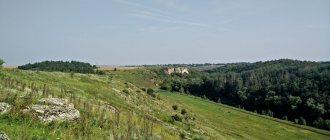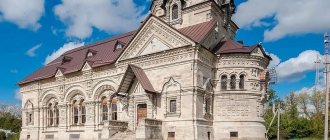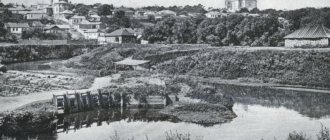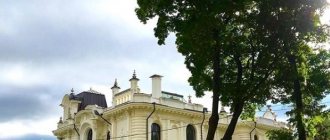There are so many beautiful places on Lipetsk land! There were many great people here, each of whom left their own story here. This history is manifested not only in legends and chronicles, but also in architecture. Many historical architectural monuments have survived to this day. This article will tell you about famous people and architectural monuments of Lipetsk land.
- Balovnevo
- Ascension Cathedral in Yelets
- Ancient Assumption Church
- Gubin House
- Znamenskoye
- Palna-Mikhailovka
- Polibino
- The Sheremetev estate in the village of Borki
- Nativity of Christ Cathedral
Balovnevo
The village of Balovnevo is located seven miles southwest of the city of Dankov, formerly in the Ryazan province (now Lipetsk region). The name of the village was first found in scribe books in 1626. It was named after the owner of Dankovo and ataman Balovnev.
The currently existing manor complex was formed in the last quarter of the 17th - early 19th centuries. Its construction was started by Matvey Vasilyevich Muromsky, lieutenant general, first Tula governor. Then the estate was successively owned by the Muromtsevs: Matvey Matveevich, Leonid Matveevich, Nikolai Leonidovich, and from 1900 - the famous painter E.E. Volkov-Muromtsev, maternal heir.
Having started construction of the estate, M.V. Muromtsev invited the best specialists to create it. It is no coincidence that many consider the author of the manor house project to be V.V. Rastrelli, and the temple project is attributed to the work of V.I. Bazhenova. The Muromtsev estate resembled one of the royal summer residences. They said that all this was built to receive Catherine, whose personal secretary and favorite was M.V. Muromtsev.
Currently, among the surviving buildings in the village of Balovnevo, the Vladimir Church, located not far from the palace, attracts special attention. The church was built in a classical style, but has an unusual volumetric-spatial composition and some decorative details. The peculiarity of the temple is the absence of an apse, but the refectory, equal in width to the temple part, with a high roof, up to the level of the third tier of the temple, which gives the church a resemblance to the buildings of Western Europe. The similarity is enhanced by the presence of two bell towers.
After the revolution, the estate was plundered. In 1918, the palace burned down, and then it was dismantled into bricks. In 1920, outbuildings were destroyed. In the 1930s, the iron was removed from the roof of the Vladimir Church and the church fence was broken. A grain warehouse was set up in the temple. There was a glacier in the Muromtsev crypt.
In recent years, the estate complex, which is a monument of federal significance, has been slowly dying. The outbuildings of the palace are abandoned and destroyed, the garden and parks are cut down.
Bibliography
Balovnevo // Lipetsk Encyclopedia: in 3 volumes / ed.-comp. B.M. Shalnev, V.V. Shakhov. - Lipetsk, 1999. - T. 1. - P. 78. Vladimir Church / / Travel around the Lipetsk region / comp. V.F. Polyansky, N.V. Markov, A.F. Martynov. - Voronezh, 1971. - P. 140 - 143. Klokov, A.Yu. Balovnevo. Muromtsev estate / A.Yu. Klokov // Russian provincial estates / comp. R.V. Andreeva, A.F. Popova. - Voronezh, 2001. - P. 324 - 332. Konstantinov, V. The temple is being reborn: [revival of the temple in the village. Balovnevo] / V. Konstantinov / / Testaments of Ilyich. - 2004. - September 23. - WITH. . Merlev, A. How the temple of God was dying: [the plight of the Vladimir Church in Balovnevo] / A. Merlev, A. Kosyakin / / Lipetsk newspaper. - 2002. - February 27. - P. 2 - 3. Ovcharova, T. Two pearls of Bazhenov: [Church of the Sign in Veshalovka and Vladimirskaya in Balovnevo] / T. Ovcharova // Metallurgist. — 2001.—July 13. - P. 30. Rudakov, L.E. In the footsteps of legends / L.E. Rudakov. - Voronezh, 1980. - P. 112 - 114. Ancient estates (Balovnevo, Polibino) // Guide to the Lipetsk region / comp. Z. I. Esipova, G. V. Tarasova. - Lipetsk, 2003. - P. 48. Tambovskaya, A. Trees die standing...: [the plight of the parks Polibino, Troekurovo, Trubetchino, Balovnevo] / A. Tambovskaya / / Lipetskaya newspaper. - 2003. - October 15. — P. 4.
Ascension Cathedral in Yelets
Ascension Cathedral, a monument of architectural architecture. Located in Yelets, Lipetsk region. Located on Red Square - the central part of Yelets. Built from 1845 to 1889. The author of the project is K.A. Tone. The height of the Ascension Cathedral together with the cross is 74 m, length - 84 m, width 34 m. It took 44 years to build, but remained unfinished. The bell tower, designed 10 meters above the base of the dome, remained unfinished.
The Ascension Cathedral consists of a cubic quadrangle topped with five onion-shaped domes resting on octagonal light drums; from the refectory and the unfinished bell tower. The altar part of the Ascension Cathedral has three semicircular apses. The temple is four-pillar, one-story. In the exterior design of the building, the architect used stylized forms of Russian and Byzantine architecture, adopted for small ancient Russian churches. These include an arcature belt, keel-shaped kokoshniks, pipe columns, and daisy-shaped platbands. At the same time, narrow high windows are elements of classicism.
The interior of the Ascension Cathedral is decorated with a three-tiered iconostasis made of gilded carved wood, designed by Moscow architect A.V. Kaminsky. In general, the Yelets Ascension Cathedral is a huge artistic exhibition; in the temple part alone there are more than 220 wall paintings, paintings, and icon paintings, most of which were painted by outstanding Russian artists - the Wanderers K.V. Lebedev and A.I. Korzukhina.
The decoration of the refectory now includes about 150 works of art. Undoubtedly, the wall paintings and icons of the cathedral, different in their artistic merits and manner of execution, are a unique historical and artistic property of Yelets.
Bibliography
Ascension Cathedral // Yelets / ed. V.P. Gorlova. - Voronezh, 1978. - pp. 143 - 144. Ascension Cathedral / / Lipetsk Encyclopedia: in 3 volumes / ed. - comp. B.M. Shalnev, V.V. Shakhov. - Lipetsk, 1999. - T.1. — P. 212-213. Ascension Cathedral // Guide to the Lipetsk region / comp. Z.I. Esipova, G.V. Tarasova. - Lipetsk, 2003. - P. 82. Gorlov, V. Interior decoration: [decoration of the Ascension Cathedral] / V. Gorlov / / Red Banner. - 1991. - July 17. Grishaev, A. Grand-ducal symbol of the ancient city: [Ascension Cathedral] / A. Grishaev // Golden Key. - 1998. - N 14. - P. 5. Tyagunov, V. The unrealized plan of the architect: [Ascension Cathedral] / V. Tyagunov / / Lenin Banner. - 1991. - February 20. Fedorova, O. Revival: [About the Ascension Cathedral in the city of Yelets] / O. Fedorova // Lipetsk news. — 1998. — Aug. 28. — P. 12.
Ancient Assumption Church
The Ancient Assumption Church is an architectural monument of republican significance at the end of the 17th century and is the oldest building in the city. Located on the street. Saltykov-Shchedrin - the former settlement "Monastyrka", which was named after the monastery "Paroyskaya Hermitage", founded at the beginning of the 17th century.
The church is bell-free - an octagon on a two-height quadrangle with a semicircular apse and a chapel of St. Nicholas the Wonderworker. It was built in several stages, which can be seen in the masonry. The year of construction is unknown. The northwestern chapel of St. Nicholas the Wonderworker was consecrated by Ryazan Metropolitan Stefan (Yavorsky) in 1701.
Features of the temple: the altar is oriented to the northeast, there is an underground passage. To the north of the temple on the slope there was a wooden bell tower (the foundations have been preserved), built in 1885. On the northern and western sides there was a necropolis. On the south-eastern side in 1878, according to the design of A. Andreev, a wooden chapel was built over the source, where the icon of the Mother of God “Life-Giving Spring” miraculously appeared. According to legend, Peter I visited this spring. On the southwestern side of the temple there was a two-story clergy house built in the second half of the 19th century. The Paroiskaya Hermitage monastery was abolished in 1764. The surviving Assumption Church was without a parish.
The church was closed in 1938 “at the request of the sanitary inspectorate”, after which it was severely destroyed, completely losing the iconostasis, paintings and interior details. The restoration of the temple, which began in the 1970s, was completed after its transfer to the regional museum in 1991. Until 1996. In the church premises there was an exhibition dedicated to the history of metallurgical production and metalworking in the region.
Bibliography
Grishaev, A. The underground secret of the city: [underground passages of the Ancient Assumption Church] / A. Grishaev // Golden Key. - 1994. - N 12. - P. 7. Ancient Assumption Church of Lipetsk / / Lipetsk Encyclopedia: in 3 volumes / ed.-comp. B.M. Shalnev, V.V. Shashov. - Lipetsk, 1999. - T. 1. - P. 358. Ancient Assumption Church in Lipetsk // Rudakov L.E. In the footsteps of legends / L.E. Rudakov. - Voronezh, 1980. - P.99 - 104. An icon from the water fell into the temple: [history of the Ancient Assumption Church] // De facto. - 1998. - April 17 - 22 - St. 1. Medvedev, V.A. Road to the temple: [Ancient Assumption Church] / V.A. Medvedev // Lipetsk newspaper. — 2002.—February 21—S. 6. Architectural monument - Ancient Assumption Church / / Koltakov V.M. Memorable places of Lipetsk / V.M. Koltakov. — Voronezh, 1976.—S. 5 - 7. Architectural monument - Ancient Assumption Church / / Travel around the Lipetsk region / comp. V.F. Polyansky, N.V. Markov, A.F. Martynov. — Voronezh, 1971.—S. 28 - 29. Tyagunov, V. A few more materials about the Ancient Assumption Church in Lipetsk / V. Tyagunov / / Holy Rus'. — 1994.—Sept. 29. Tyagunov, V. St. Nicholas chapel of the Ancient Assumption Church is 300 years old / V. Tyagunov / / De facto.-2001.-18 - 20 Dec.-S. 2. Shurygina, T. Ancient Assumption Church / T. Shurygina / / Golden Key. — 1999.—N 3. — P. 5.
Gubin House
On Lenin Street in Lipetsk there is one ancient building with columns, known as the house of General Gubin. The history of its construction goes back to the distant past: the end of the 13th - beginning of the 19th centuries. Historical documents tell us that the ancestors of A.S. Pushkin's maternal side began the construction of this building. Here was their city estate, and their summer “dacha” was located in the village of Korenevshchino. At the beginning of the 19th century, the Pushkins finally moved to Moscow, then to St. Petersburg. And the Lipetsk estate was acquired by the widow of the district solicitor Grishin. The widow, in turn, resold the dismantled house to the staff doctor of the Lipetsk resort F.I. Turovsky, who built the best house in Lipetsk at that time and surrounded it with a large park with ponds. The Turovskys owned this house until the 1890s. According to documents from 1896, the estate was owned by A.M. Gubina.
In 1917 General Gubin's house was confiscated and transferred to the jurisdiction of the Council of Local People's Judges, and in 1918. The military commissariat moved there. In the 30s, General Gubin lived in Yelets. His daughter Evgenia Aleksandrovna Glinka told Yelets local historians that A.S. visited the Lipetsk resort during one of the fashionable summer seasons. Pushkin. He danced in their house, at balls given by the Turovskys. Fedor Ivanovich was for some time the director of Lipetsk Mineral Waters. Pushkin A.S. I came here even before my marriage to meet a certain artist Kachanova. At the same time, he went to the village of Kapitanschino, Butyrskaya volost, to see N. Zamyatin; all the residents of the village, which once belonged to the poet’s great-grandfather Alexei Fedorovich Pushkin, came out to meet him. It is difficult to judge how plausible this message is. Evgenia Aleksandrovna Glinka died a long time ago.
In 1974 By decree of the Council of Ministers of the RSFSR, the building was taken under state protection as a monument of history and culture of federal significance. In 2001 It was decided to house an art gallery in this building. The building is undergoing restoration work.
Bibliography
Gubin's House // Travel around the Lipetsk region / comp. V.F. Polyansky, N.V. Markov, A.F. Martynov. — Voronezh, 1971.—S. 40 - 41. Klokov, A. Waiting for the buffet table: [Gubin’s House; restoration of the building] / A. Klokov / / Lipetsk News. - 2005. - March 9. - P. 5. Kukrak, S. Legends and were of the old house: [The House of Gubin and celebrities] / S. Kukrak // Lipetsk newspaper. - 1997. - July 6. — P. 5. Monument to the art gallery: [Gubin House] // De facto. - 2001. - 20 - 22 February. - P. 2. Smirnov, N. Once again about Gubin’s house: [restoration] / N. Smirnov // Lipetsk newspaper. — 2005. — April 16. — P. 6.
Znamenskoye
The Znamenskoye estate is located on the territory of the Lipetsk district of the Lipetsk region in the village of Veshalovka (the former village of Znamenskoye of the Lipetsk district of the Tambov province, after 1917 it became part of the village of Veshalovka).
The history of the village of Znamenskoye can be traced through documents from the second half of the 17th century and belongs to the ancient Tatishchev family. The Tatishchev family originates from the Smolensk princes of Solomersky. In 1804, the Tatishchevs sold the Znamenskoye estate to artillery captain Ivan Iosifovich Kozhin. After the death of I.F. Kozhina Znamenskoye goes to Mikhail Ivanovich Kozhin. After the death of M.I. Kozhin, his eldest son Alexander Mikhailovich Kozhin will become the owner of the estate. After the death of A.I. Kozhina (43 years old), the estate is inherited by his wife Margarita Semyonovna (owned it until 1917).
The site of the estate in the village of Znamensky was chosen on the high northern side of the ravine. On its left side stood the Church of the Sign of the Icon of the Mother of God; to the right, 300 meters away, stood a manor house. The beginning of the development of the estate is considered to be 1768, when the church was founded. It was built in 1784. The final date of construction is considered to be 1794.
The author of the project for the Church of the Sign was the then young architect Vasily Ivanovich Bazhenov. The architecture of the church is unusual for central Russia: it was built in a pseudo-Gothic style and more closely resembles a temple in Western Europe.
The estate was built on lands with close groundwater, so drainage channels were laid around the buildings. To the south there was a cascade of ponds. 300 meters east of the manor house, behind the pond, a large orchard was laid out. Outbuildings and services were located behind the orchard. In 1918, the manor house burned down. The Lipetsk district government sold the estate for scrap.
The Znamenskoye estate ceased to exist in the 20s of the last century. Only part of it has survived to this day: the Church of the Sign, the chapel with the family tomb of the Kozhins (the last owners of the estate), the corner tower of the large palace, a neglected orchard, the remains of a park, and washed out dams of ponds.
Znamenskoye is an architectural monument of the 17th - 19th centuries of federal significance, but so far it is “protected” only on paper.
Bibliography
Veshalovka / Lipetsk Encyclopedia: in 3 volumes/ed.-compiled by B.M. Shalnev, V.V. Shakhov.—Lipetsk, 1999.—T. 1. - pp. 197-198. Architectural monument in the village of Veshalovka / / Guide to the Lipetsk region / comp. Z.I. Esipova, G.V. Tarasova. - Lipetsk, 2003. P. 25 - 26 Rudakov, L.E. In the footsteps of legends / L.E. Rudakov.—Voronezh, 1980. — P. 111 — 112. Seleznev, N.P. Znamenskoye / N.P. Seleznev // Russian provincial estates / comp. R.V. Andreeva, L.F. Popova.—Voronezh, 2001.—S. 310 - 315. Estate “Znamenskoye” / Lipetsk Encyclopedia: in 3 volumes / ed.-comp. B.M. Shalnev, V.V. Shakhov. - Lipetsk, 2001. - T. 3. - P. 394. Masterpiece in Veshalovka // Travel around the Lipetsk region / comp. V.F. Polyansky, N.V. Markov, A.F. Martynov.—Voronezh, 1971. — P. 138 — 140.
Palna-Mikhailovka
One of the “rare oases of culture” is the village of Palna-Mikhailovka, located 15 km north of the city of Yelets. Near this village, on the Palna River, there is an old landowner’s estate, which since the end of the 18th century belonged to the famous freemason M.V. Pervago. M.V. Pervago was very fond of decorative art and he himself planned a large park and garden on 26 acres in the Palnovskaya estate. The house was built in the Russian Empire style. Its design was compiled by the famous architect A.L. Vitberg. Vitberg's Palnovsky house went down in the history of Russian architecture as an exemplary monument of wooden classicism in the first third of the 19th century. The palace burned down twice and was rebuilt, but still retained the charm of its original, neoclassical style thanks to the fact that the popular master of decorative painting D.B. was invited to Palna. Scotty. Scotti's grisaille paintings (in one or two tones) were distinguished by sculptural clarity and created the illusion of bas-relief. Currently, the paintings have not been preserved, since the house burned down twice. There is another interesting building in the same estate. This is a small church-mausoleum, built according to the plan of the famous Moscow architect D.I. Gilardi (1788-1845). This is a round, blank building with a dome on a drum, decorated with one portico on the west side. With its strict simplicity and ponderous monumentality, it resembles the Roman Pantheon.
Subsequently, opposite the old palace on the opposite bank of the river, another two-story palace in the Gothic style was erected. It was badly damaged during the war (1941-1945), but has not yet lost its original appearance. The Gothic style of this estate is emphasized by pyramidal oak trees.
Palna-Mikhailovka became known as a bright provincial center of Russian cultural life in the middle of the 19th century, when the estate was owned by Mikhail Alexandrovich (1820-1858) and Alexander Alexandrovich (1830-1913) Stakhovich. The brightest personality here was, of course, Mikhail Aleksandrovich Stakhovich - poet, writer - playwright, folklorist, musician-theorist, local historian. Outstanding writers, poets, artists, and actors often visited the owners of the estate.
Bibliography
Eletskikh, A. The Stakhovich family and the Terbunsky region / A. Eletskikh / / Lighthouse. - 2003. - September 23. - P. 2. Krasnova, S. Noble nest Palna-Mikhailovka / S. Krasnova / / Lipetsk Land: historical heritage: culture and art / ch. ed. A.M. Tarunov. - St. Petersburg, 2003. - P. 160-165. Krasnova, S. Palna-Mikhailovka - a rare oasis of culture / S. Krasnova / / Russian provincial estates of the 18th - early 20th centuries. - Voronezh, 2001. - P. 242-258. Palna-Mikhailovka and Stakhovichi // Travel around the Lipetsk region / comp. V.F. Polyansky, N.V. Markov, A.F. Martynov. - Voronezh, 1971. - P. 145-158. Stanovlyansky district. Manor in Palna-Mikhailovka // Guide to the Lipetsk region: in 2 hours / comp. Z.I. Esipova. - Lipetsk, 2004. - Part 2. - P. 102-104. The ancient park should not be abandoned: [the ancient park of the Stakhovichi estate] // Zvezda. - 2003. - December 16. — P. 3. The Stakhovichi estate in the village of Palna-Mikhailovka // Guide to the Lipetsk region / comp. Z.I. Esipova, G.V. Tarasova. - Lipetsk, 2003. - pp. 87-89.
Polibino
A manor complex in the village of Polibino (Storozhevoye) in the Dankovsky district of the Lipetsk region, the former Dankovsky district of the Ryazan province. The village is located on the right bank of the Don River, opposite the old Dankovsky settlement. It was first mentioned in the census books of the Dankovsky district in 1676, the name was named after the owner, steward B.F. Polibina. Later, the estate passes to the Nechaev family.
The Nechaev noble family descends from Fyodor Nechaev, a boyar of the Grand Duke Simeon the Proud (1300). The history of the estate is directly connected with the name of three representatives of this noble family: Dmitry Stepanovich Nechaev, his son Stepan Dmitrievich Nechaev and son S.D. Nechaeva Yuri Stepanovich Nechaev-Maltsev. The new owners of the village, the Nechaevs, are rebuilding a manor complex here with a palace of “Rastrelli architecture” and a vast park. The estate housed the first museum of the history of the Battle of Kulikovo, where finds from the Kulikovo field were collected. This landmark of the estate was noted by P.P. Semenov-Tyan-Shansky.
The landmark of the estate is the water tower of a mesh structure 45 meters high, with a reservoir with a capacity of 9,500 buckets, designed by the outstanding engineer V.G. Shukhova. Purchased by Yu.S. Nechaev-Maltsev at the Nizhny Novgorod Industrial Exhibition in 1896. This is the first construction of a mesh structure in the history of technical thought.
Gradually, over the course of the 18th-19th centuries, a manor complex of rare beauty and historical significance was created in Polibino. The complex, which was fully formed by the end of the 19th century, included: a palace, an English park, a huge garden and a cascade of ponds, outbuildings, including an arena and a stable, a water tower and a pumping station, a laundry with a dryer and other buildings. All this was created by three generations of owners (Nechaevs).
On November 2, 1971, the estate was declared a monument of republican significance. In the same year, the Polibino estate was declared a monument of federal significance and, despite the destruction and loss, was included in the excursion route.
Today, the palace and the Shukhov water tower are in disrepair. The arena was completely dismantled into bricks, the stable was destroyed. Landscape buildings today are in an abandoned state or destroyed. The garden and park complex, which is a natural monument, is slowly dying: the park is being built up, most of the garden was uprooted back in 1976.
The palace is guarded on a voluntary basis by local historian Ivan Kuzmich Laktionov.
Bibliography
Klokov, A. Polibino / A. Klokov / / Lipetsk Encyclopedia: in 3 volumes / ed.—comp. B.M. Shalnev, V.V. Shakhov. - Lipetsk, 2001. - T. 3. - P. 80. Klokov, A. Polibino. Nechaev estate / A. Klokov / / Russian provincial estates / comp. R.V. Andreeva, L.F. Popova. - Voronezh, 2001. - P. 274-282. Melikhova, G. Riddles of Polibino / G. Melikhova / / Testaments of Ilyich. — 2001. — Jan. 23, Jan. 30, Feb. 6, Feb. 13. Rudakov, L.E. In the footsteps of legends / L.E. Rudakov. - Voronezh, 1980. - pp. 114-115. Ancient estates (Balovnevo, Polibino) // Guide to the Lipetsk region / comp. Z.I. Esipova, G. V. Tarasova. - Lipetsk, 2003. - P. 49. Tambovskaya, A. Trees are dying while standing...: [the plight of the parks Polibino, Troekurovo, Trubetchino, Balovnevo] / A. Tambovskaya / / Lipetsk newspaper. — 2003. — Oct. 15. — P. 4.
The Sheremetev estate in the village of Borki
The estate complex in the village of Borki is an architectural monument of the last quarter of the 19th century, built in the Romanov style.
The palace, built of rubble stone and gray stained sandstone, used to make the elements of the palace that are most susceptible to weathering, has been preserved. Outbuildings made in the same style have been preserved. The southern facade of the palace, the center of the volumetric composition of which was a two-story building with a round tower, faces the slope of a deep ravine occupied by an orchard. The park is planned in the English style, decorated with exhibitions of large glacial boulders of gray sandstone. The park overlooks the steep bank of the Olym River.
The estate was the center of the Sheremetev estate with developed field farming and a stud farm. Since 1893, on the territory of the estate there was a zemstvo tree nursery, where seedlings of various species were grown.
The interiors of the palace were destroyed in 1941 as a result of a fire. Later, the arch of the palace was laid, the roof and part of the window openings were modified. At the same time, the self-regenerating park was cut down. Currently, its central alley is clearly visible. For a long time, the Borkiv secondary school was located in the manor house.
Bibliography
Eletskikh, A. The death of the castle: [history of the castle in the village. Borki] / A. Eletskikh / / Lighthouse. — 2003. — April 1, April 5. Eletskikh, A. At the Sheremetevsky Castle / A. Eletskikh / / Work -7. - 2001. - July 19. — P. 20. Castle in Borki // Lipetsk Land: historical heritage: culture and art / ch. ed. A.M. Tarunov. - M, 2003. - P. 183. The Sheremetev estate in the village of Borki // Guide to the Lipetsk region. - Lipetsk, 2003. - P. 71-72.
Nativity of Christ Cathedral
This architectural monument as a whole was formed from 1791 to 1842. In accordance with the traditional scheme, the cathedral has three components: the church itself, the refectory and the bell tower. The bell tower was built in 1825 - 1835. The refectory - after 1839 and consecrated in 1842. There are five thrones.
On highly solemn days, up to 2,500 people gathered in the cathedral. The cathedral had an unusually rich interior decoration. Inside, the cathedral resembled an art gallery. On the walls there were about 30 paintings by famous artists of the Italian school. Until 1917, the cathedral had: running water, steam heating with a steam pump, electric lighting with 800 light bulbs. The church was surrounded by an iron fence on a brick foundation with two gates and three wickets.
After 1917 the cathedral was looted and closed on June 26, 1931. Until the 50s, the cathedral was used as a warehouse, but it was decided to transfer the dilapidated building to the local history museum. In 1957, its restoration began, and for many years the cathedral housed a local history museum. In 1991, at the request of the residents of Lipetsk, the cathedral was handed over to believers. On January 8, 2001, the relics of 82 holy ascetics of the Kiev-Pechersk were transferred to the Nativity Cathedral.
Bibliography
Alexandrova, D.V. City center - in the center of history: [Cathedral Square. Nativity Cathedral] / D. Alexandrova / / Youth Bulletin.—2005. — Apr 22 - P. 12. Kolesnichenko, G. New solo for striking clocks: [the main city clock will work again at the Nativity Cathedral] / G. Kolesnichenko // Lipetsk newspaper. - 2004. - N 47.-S. 3. Medvedev, V.A. Road to the temple: [Christ Nativity Cathedral] / V.A. Medvedev // Lipetsk newspaper. - 2002. - February 21. - P. 6. Architectural monument - Cathedral - Rudakov L.E. In the footsteps of legends / L.E. Rudakov.—Voronezh, 1980.—S. 130 - 135. Architectural monument Cathedral on Lenin Square // Travel around the Lipetsk region / comp. V.F. Polyansky, N.V. Markov, A.F. Martynov.—Voronezh, 1971.—S. 41 - 44. Saiko, S. Will serve great-grandchildren: [from the history of the Nativity Cathedral] / S. Saiko / / Lipetsk news. - 1997. - December 19 - p. 15. Cathedrals. Nativity Cathedral / / Lipetsk Encyclopedic Sovar / comp. V.V. Shakhov. — Lipetsk, 1994.—S. 402.
In the photo of the introductory part of the material - Lipetsk diocesan administration on Lenin street, 34
Balovnevo
The village of Balovnevo is located seven miles southwest of the city of Dankov, formerly in the Ryazan province (now Lipetsk region). The name of the village was first found in scribe books in 1626. It was named after the owner of Dankovo and ataman Balovnev.
The currently existing manor complex was formed in the last quarter of the 17th - early 19th centuries. Its construction was started by Matvey Vasilyevich Muromsky, lieutenant general, first Tula governor. Then the estate was successively owned by the Muromtsevs: Matvey Matveevich, Leonid Matveevich, Nikolai Leonidovich, and from 1900 - the famous painter E.E. Volkov-Muromtsev, maternal heir.
Having started construction of the estate, M.V. Muromtsev invited the best specialists to create it. It is no coincidence that many consider the author of the manor house project to be V.V. Rastrelli, and the temple project is attributed to the work of V.I. Bazhenova. The Muromtsev estate resembled one of the royal summer residences. They said that all this was built to receive Catherine, whose personal secretary and favorite was M.V. Muromtsev.
Currently, among the surviving buildings in the village of Balovnevo, the Vladimir Church, located not far from the palace, attracts special attention. The church was built in a classical style, but has an unusual volumetric-spatial composition and some decorative details. The peculiarity of the temple is the absence of an apse, but the refectory, equal in width to the temple part, with a high roof, up to the level of the third tier of the temple, which gives the church a resemblance to the buildings of Western Europe. The similarity is enhanced by the presence of two bell towers.
After the revolution, the estate was plundered. In 1918, the palace burned down, and then it was dismantled into bricks. In 1920, outbuildings were destroyed. In the 1930s, the iron was removed from the roof of the Vladimir Church and the church fence was broken. A grain warehouse was set up in the temple. There was a glacier in the Muromtsev crypt.
In recent years, the estate complex, which is a monument of federal significance, has been slowly dying. The outbuildings of the palace are abandoned and destroyed, the garden and parks are cut down.
Gubin House
On Lenin Street in Lipetsk there is one ancient building with columns, known as the house of General Gubin. The history of its construction goes back to the distant past: the end of the 13th - beginning of the 19th centuries. Historical documents tell us that the ancestors of A.S. Pushkin's maternal side began the construction of this building. Here was their city estate, and their summer “dacha” was located in the village of Korenevshchino. At the beginning of the 19th century, the Pushkins finally moved to Moscow, then to St. Petersburg. And the Lipetsk estate was acquired by the widow of the district solicitor Grishin. The widow, in turn, resold the dismantled house to the staff doctor of the Lipetsk resort F.I. Turovsky, who built the best house in Lipetsk at that time and surrounded it with a large park with ponds. The Turovskys owned this house until the 1890s. According to documents from 1896, the estate was owned by A.M. Gubina.
In 1917 General Gubin's house was confiscated and transferred to the jurisdiction of the Council of Local People's Judges, and in 1918. The military commissariat moved there. In the 30s, General Gubin lived in Yelets. His daughter Evgenia Aleksandrovna Glinka told Yelets local historians that A.S. visited the Lipetsk resort during one of the fashionable summer seasons. Pushkin. He danced in their house, at balls given by the Turovskys. Fedor Ivanovich was for some time the director of Lipetsk Mineral Waters. Pushkin A.S. I came here even before my marriage to meet a certain artist Kachanova. At the same time, he went to the village of Kapitanschino, Butyrskaya volost, to see N. Zamyatin; all the residents of the village, which once belonged to the poet’s great-grandfather Alexei Fedorovich Pushkin, came out to meet him. It is difficult to judge how plausible this message is. Evgenia Aleksandrovna Glinka died a long time ago.
Ascension Cathedral in Yelets
Ascension Cathedral, a monument of architectural architecture. Located in Yelets, Lipetsk region. Located on Red Square - the central part of Yelets. Built from 1845 to 1889. The author of the project is K.A. Tone. The height of the Ascension Cathedral together with the cross is 74 m, length - 84 m, width 34 m. It took 44 years to build, but remained unfinished. The bell tower, designed 10 meters above the base of the dome, remained unfinished.
The Ascension Cathedral consists of a cubic quadrangle topped with five onion-shaped domes resting on octagonal light drums; from the refectory and the unfinished bell tower. The altar part of the Ascension Cathedral has three semicircular apses. The temple is four-pillar, one-story. In the exterior design of the building, the architect used stylized forms of Russian and Byzantine architecture, adopted for small ancient Russian churches. These include an arcature belt, keel-shaped kokoshniks, pipe columns, and daisy-shaped platbands. At the same time, narrow high windows are elements of classicism.
The interior of the Ascension Cathedral is decorated with a three-tiered iconostasis made of gilded carved wood, designed by Moscow architect A.V. Kaminsky. In general, the Yelets Ascension Cathedral is a huge artistic exhibition; in the temple part alone there are more than 220 wall paintings, paintings, and icon paintings, most of which were painted by outstanding Russian artists - the Wanderers K.V. Lebedev and A.I. Korzukhina.
The decoration of the refectory now includes about 150 works of art. Undoubtedly, the wall paintings and icons of the cathedral, different in their artistic merits and manner of execution, are a unique historical and artistic property of Yelets.
Ancient Assumption Church
The Ancient Assumption Church is an architectural monument of republican significance at the end of the 17th century and is the oldest building in the city. Located on the street. Saltykov-Shchedrin - the former settlement "Monastyrka", which was named after the monastery "Paroyskaya Hermitage", founded at the beginning of the 17th century.
The church is bell-free - an octagon on a two-height quadrangle with a semicircular apse and a chapel of St. Nicholas the Wonderworker. It was built in several stages, which can be seen in the masonry. The year of construction is unknown. The northwestern chapel of St. Nicholas the Wonderworker was consecrated by Ryazan Metropolitan Stefan (Yavorsky) in 1701.
Features of the temple: the altar is oriented to the northeast, there is an underground passage. To the north of the temple on the slope there was a wooden bell tower (the foundations have been preserved), built in 1885. On the northern and western sides there was a necropolis. On the south-eastern side in 1878, according to the design of A. Andreev, a wooden chapel was built over the source, where the icon of the Mother of God “Life-Giving Spring” miraculously appeared. According to legend, Peter I visited this spring. On the southwestern side of the temple there was a two-story clergy house built in the second half of the 19th century. The Paroiskaya Hermitage monastery was abolished in 1764. The surviving Assumption Church was without a parish.
The church was closed in 1938 “at the request of the sanitary inspectorate”, after which it was severely destroyed, completely losing the iconostasis, paintings and interior details. The restoration of the temple, which began in the 1970s, was completed after its transfer to the regional museum in 1991. Until 1996. In the church premises there was an exhibition dedicated to the history of metallurgical production and metalworking in the region.











